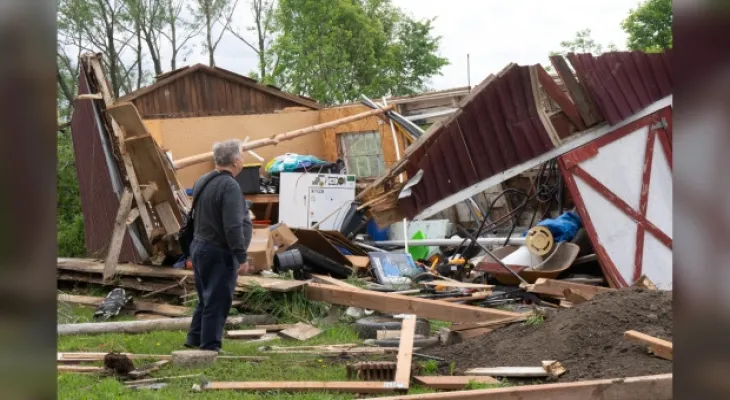Search here
Newspaper
Search here

Arab Canada News
News

Published: August 7, 2024
On July 24, the Canadian Ministry of the Environment issued a warning of a potential tornado in the area surrounding the town of Lachute in Quebec, northwest of Montreal, urging people to seek shelter.
The warning was accurate: a tornado struck outside the town of Lachute about an hour after the warning was issued. However, three other tornadoes that day did not exceed the forecasts of meteorological experts.
In the following days, the ministry confirmed that tornadoes also formed on July 24 over the municipalities of Brossard and Boucherville, located on the southern shore of Montreal, and west of Quebec City in Cap Santé. None of those tornadoes were preceded by warnings from the ministry, which only issued warnings for severe thunderstorms.
Predicting where tornadoes will form is difficult, and meteorologists in Canada do not have an excellent record: between 2019 and 2021, only 23 percent of tornadoes were preceded by a warning, a figure that rose slightly to 35 percent in 2022, according to the Northern Tornadoes Project, a research group at Western University in London, Ontario.
When a suspected tornado strikes, researchers from the group head to the field to investigate and share findings with the federal government. David Sills, the executive director of the Tornado Project, says Environment Canada has recently improved its tornado warning program, but he says the agency should issue more warnings – even if officials are not always accurate.
Sills said in a recent interview, "The public loses trust when they receive a warning after damage has occurred or do not receive any warning at all," adding, "That’s really when they lose trust in the system."
Sills stated that the ministry should train its meteorologists to assess unexpected weather patterns faster and to use data derived from radar and satellite imagery better for forecasts.
The federal government uses a variety of special alerts to inform the public about tornadoes. The most urgent are Alert Ready messages, which are sent directly to mobile phones and interrupt television and radio broadcasts.
Over the past five years, the number of Alert Ready tornado warnings issued by the Ministry of the Environment has sharply increased. In 2019, 85 warnings were issued, and by 2023 the number jumped to 674, with 538 so far in 2024. In Quebec, there were only three tornado alerts in 2019, but that number rose to 85 in 2023, and there have been 41 so far this year in 2024.
The increase in warnings does not necessarily mean there are more tornadoes. Members of the Tornado Project and officials at Environment Canada say the spike is due to better detection equipment and more investigators. Sills mentioned that the pressure from his group has prompted officials to broadcast more warnings, although he states that they should issue even more.
Sills asserted that sending warnings via mobile phones has definitely saved lives.
In Quebec and Ontario in 2022, he said that fast-moving severe storms caused 16 fatalities. "They were all just people who weren’t able to get out of the way quickly enough."
Alert Ready messages are automatically activated in the event of a tornado or severe thunderstorm with winds exceeding 130 kilometers per hour or when at least 7 centimeters of hail is forecasted.
Joanne St. Croix, the director of forecasting services in Quebec and Ontario at Environment Canada, stated, "Weaker tornadoes are harder to predict."
St. Croix confirmed that the agency invested in new radar equipment in 2023 and in updated training for meteorologists to better recognize tornadoes and thunderstorms. The ministry is also trialing a tornado forecasting model that is widely used in the United States. Currently, the agency divides the country into fixed geographical zones for issuing alerts, meaning that people living in the city may receive a tornado warning for a rural area far from their location.
Instead, St. Croix mentioned that the agency wants to use a more flexible polygonal shape to define tornado warning boundaries, which would make alerts more accurate. She added that the agency also plans to launch a color-coded alert system by next year to more easily communicate risk levels to the public for all severe weather events.
While there may not be conclusive evidence that the number of tornadoes in Canada is increasing, Sills' group is certainly busy. On Tuesday, a team from the Northern Tornadoes Project is set to begin investigating potential damage from the tornado over the weekend in Quebec along the St. Lawrence River, including the municipalities of Sorel-Tracy, Batiscan, and Saint-Élie-de-Caxton.
Comments